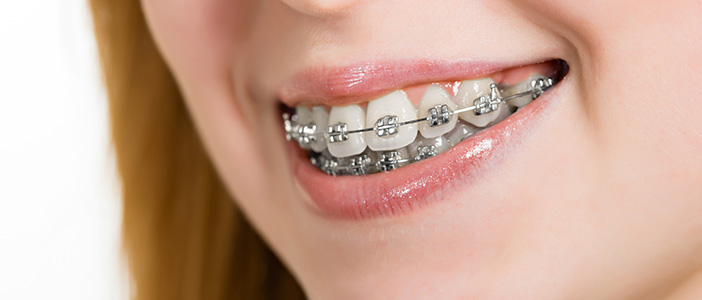When Should I Get Braces?
Article Featured on KidsHealth
Show your Oregon pride with our new Oregon Ducks Braces! Call Biermann Orthodontics today for a free consultation!
Some kids can’t wait to get their braces, seeing them as a sign that their teen years can’t be far behind. Others, though, worry about what they’ll feel or look like.
However your child feels, you probably have some questions and concerns of your own about braces. Here’s the lowdown on kids and braces.
Why Kids Need Braces
Kids can need braces for any number of reasons, including crooked, overlapping, or overcrowded teeth, or a “bad bite” (known as malocclusion). Malocclusion is when there’s a difference in the sizes of the top and bottom jaws. When the upper jaw is bigger than the lower jaw, it’s called an overbite. When the lower jaw is bigger, it’s called an underbite.
Sometimes tooth and jaw problems can be caused by tooth decay, losing baby teeth too soon, accidents, or habits like thumb sucking. But often they’re inherited, so if you or someone in your family needed braces, it’s likely that your kids will, too.
Often, your child’s dentist will be the first to notice problems during a regular visit and recommend that you see an orthodontist. Dr. Biermann can decide whether your child does indeed need braces and which devices would be best.
There’s no set age for a child’s first orthodontist visit — some kids go when they’re 6, some kids go when they’re 10, and some go while they’re teens. Even adults can need orthodontic treatment. Many orthodontists say kids should see an orthodontist once their permanent teeth start coming in, around age 7. At this age, issues such as uneven bite and overcrowding will become apparent.
Starting the process early doesn’t mean a child will get braces right away. It just means the orthodontist will be able to find problems and decide the best time to start treatment.
The First Orthodontist Visit
At the first visit, the orthodontist will thoroughly examine your child’s teeth, mouth, and jaw. He or she may ask your child to bite the teeth together and will also ask questions about whether your child has problems chewing or swallowing, or has ever had clicking or popping of the jaw.
The orthodontist may take X-rays of the mouth and teeth to see how the teeth are positioned and whether any permanent teeth still need to come in. He or she also may make a mold (or impression) of your child’s teeth by pressing a tray of gooey material into the top and bottom teeth. When the mold is removed and the material hardens, the result is a replica of your child’s teeth that will allow the orthodontist to decide which treatment options are best.
Type of Braces
Braces correct alignment problems by putting steady pressure on the teeth, which eventually moves them into a straighter position.
Most kids just need braces with wires and rubber bands. The wires help to move the teeth, and the rubber bands (which come in fun colors) help to correct alignment. Though metal braces are still used, so are clear or white ceramic braces, which are much less noticeable. Some even go behind the teeth (lingual braces).
In the last decade, clear removable braces that move teeth with plastic trays called aligners (rather than wires and rubber bands) have become available, but these are usually only for people without bite problems.
Some kids may need other devices, too, such as headgear (don’t worry — this is usually worn only at night!). Headgear uses a horseshoe-shaped wire that attaches to the back teeth, pushing them back and allowing more room for teeth in the front of the mouth. Dr. Biermann also might recommend that your child have one or more teeth removed to create more space in his or her mouth.
Once the braces are on, your child will have to visit the orthodontist every few weeks for monitoring and adjustments.
How long your child will need to wear braces depends on the problems we’re trying to fix, but the average is about 2 years. After that, your child might wear a specially molded retainer — a small, hard piece of plastic with metal wires or a thin piece of plastic shaped like a mouthguard. Retainers keep the teeth from wandering back to their original places.
Caring for Braces
Because it’s so easy for food to get stuck in wired braces, kids who wear them need to work extra hard to keep their teeth clean. Brushing after meals is essential, as is daily flossing (the orthodontist can give your child a special flosser to use in and around braces). Regular dental cleanings and checkups to look for cavities are also a must.
Your child should avoid certain foods (such as popcorn, hard and sticky candy, and gum) because they can damage braces. Sugary sodas and juices can be a problem, too, because they can contribute to tooth decay. Kids with clear plastic aligners should always remove them when it’s time to eat.
Because braces put pressure on the teeth, they can feel uncomfortable once in a while, especially after the orthodontist makes adjustments. Over-the-counter pain relievers can help if this happens.
See Dr. Biermann right away if your child has a loose wire or bracket, or a wire that is poking his or her mouth. If the orthodontist can’t find a problem, your child might use some soft wax to cover any sharp spots on the braces that are bothersome or rubbing against the inside of the mouth or gums.
Looking for an orthodontist in Beaverton, Oregon? Biermann Orthodontics is a cutting-edge orthodontic practice that serves Beaverton and Molalla, OR, and focuses on providing world-class customer service and efficient treatment. We strive to create stunning smiles in the shortest amount of time without ever sacrificing quality.
Visit our Locations page to find a clinic near you, or schedule an initial consultation.
Biermann Orthodontics
503-690-0722
17885 NW Evergreen Parkway, Suite 200
Beaverton, OR 97006



